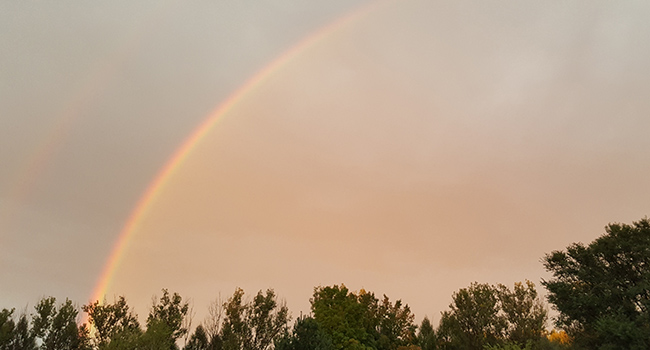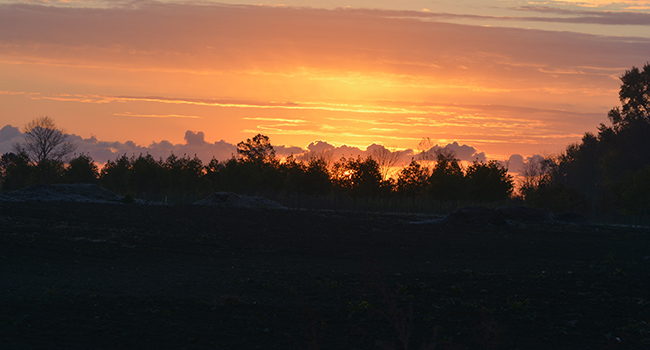 Watching the night sky has always fascinated people but daytime skies can be just as interesting.
Watching the night sky has always fascinated people but daytime skies can be just as interesting.
In July, I travelled to Nunavut as a ship naturalist on an expedition to northern Canada. I had the rare opportunity to explore parts of Baffin Island and Ungava Bay that few get to see.
While I saw wonderful wildlife, one of the other things that captured my attention was how blue the sky appeared. I presume it really wasn’t any bluer than our familiar southern skies, but the intensity was more likely a product of contrasts with the surrounding landscape, which was comprised of hues of brown, black and pale green.
Have you wondered why the sky is blue in the first place?
The reason is pretty simple. Visible light, comprised of multiple colours, typically travels through space in a straight line. If it hits an obstacle, such as dirt, it bounces off but retains its physical properties.

Comprised of very small water droplets, light is diffracted more than if the droplets were larger, so colour is manifested as light and dark areas, rather than colourful arches
However, if light hits gas molecules, which are smaller than the wavelength of visible light, some of the light gets absorbed. After a while, the molecules release or scatter the trapped light. This is known as Rayleigh scattering, after Lord John Rayleigh, a British physicist who first described the effect in the 1870s.
Since the higher frequencies (blues) are absorbed more often than the lower frequencies (reds), it’s the blue that predominates and is then radiated to the greatest degree, thus giving the sky its colour.
As the sun sets, the distance light must travel to reach our eyes increases and more of its component colours are reflected and scattered. The intensity of the blue diminishes so the sky looks very pale. As the light continues to hit particles in the air, more light is scattered and lost, and the remaining oranges and reds are evident.
We’ve all heard the phrase “Red sky in the morning, sailors take warning. Red sky at night, sailor’s delight.”
But what does it mean?
Sunlight is filtered through water vapour in the atmosphere, thus providing its red colour. The more water vapour there is in the atmosphere, the more clouds there are and so the likelihood of rain increases.
Hence, sailors travelling east believed they would encounter rain and storms as they approached these red skies. If the red sky appeared to the mariners at night, the bad weather was behind them.
I was introduced to a phenomenon called fogbows in Nunavut that summer. Similar to a rainbow, a fogbow appears in and after a fog event, rather than a rain shower. Unlike rainbows, which often exhibit intense spectral colours, fogbows are usually very pale and sometimes even white. In all cases however, it has colours at its fringes – pale shades of blue and red.

Sailors travelling east believed they would encounter rain and storms as they approached these red skies. If the red sky appeared to the mariners at night, bad weather was behind them
Comprised of very small water droplets, light is diffracted (i.e. bent) more than if the droplets were larger, so colour is manifested as light and dark areas, rather than colourful arches.
The ‘silver lining’ of a cloud is actually an effect of light diffraction. The more uniform the size of the droplets, the more colour the fogbow will exhibit, sometimes showing multiple pale inner rings, although never as bright as a rainbow.
Sailors, of course, believed in many superstitions used to guide them safely on their sea voyages and many of these relate to the condition of the sky.
They believed that halos or rings around the sun or moon were indicators of forthcoming foul weather. A ring around the moon, caused by ice crystals in the upper atmosphere, is believed to be a sign of an impending storm, and the bigger and brighter the ring, the sooner it would storm.
It was also believed that the number of stars seen inside the ring equals the number of days until the storm hits. Seeing no stars assures the storm will hit within 24 hours.
On the other hand, a ring around the sun was believed to foretell cooler stormy weather.
So you can see that sky watching isn’t as simple as looking at fluffy clouds – the sky is a complicated place where multiple physical phenomena are at work.
Geoff Carpentier is an author, expedition guide and environmental consultant. Visit Geoff online at www.avocetnatureservices.com, on LinkedIn and on Facebook.
The views, opinions and positions expressed by columnists and contributors are the author’s alone. They do not inherently or expressly reflect the views, opinions and/or positions of our publication.

